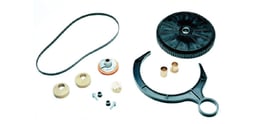What to Do If Your RO-TAP® Sieve Shaker Is Out of Spec
Test sieve analysis is a century-old technique and regarded as one of the most reliable particle size analysis methods used today. With that, the W.S. Tyler RO-TAP® Sieve Shaker upholds this reliability as it's written into dozens of industry standards.
While the RO-TAP is a respected device, you may begin to notice irregular operations. This may lead to inconsistent results over time.
If this sounds like your device, odds are it has fallen out of spec. But what does falling out of spec mean and how can you fix the problem?
W.S. Tyler has over 150 years of particle size analysis experience and our team of experts have the know-how needed to ensure your equipment is running as it should.
In this article, we will define what it means for a RO-TAP to fall out of spec and establish ways to determine if your equipment is out of spec, the factors that lead to out of spec equipment, troubleshooting techniques, and preventative steps.
What does it mean for your RO-TAP to be out of spec?
The best way to define a RO-TAP Sieve Shaker being out of spec is when your unit is operating irregularly to the point of yielding inaccurate results. This gets determined by comparing the unit’s current operational specifications to the working specifications designated by the manufacturer.

Manufacturing specifications are a list of tolerances that dictate how your RO-TAP should be performing. This includes oscillation speed, oscillation displacement, the number of hammer taps per minute, the hammer weight, and RPMs of the motor.
Before shipment, each RO-TAP gets tested to ensure all aspects of the device are operating in compliance with these specifications.
How to Determine if your RO-TAP Device is Out of Spec
There are several ways to determine if your RO-TAP unit is out of spec in-house. If you notice the tapping motion of the hammer is irregular, the unit itself making unusual sounds, or the oscillating motion is not moving at its normal speed, odds are your unit is not meeting manufacture specification.
If you suspect that your RO-TAP device is out of spec, one of the first things you should do is refer to the manufacturing specs that get shipped with the unit. These specifications are as followed:
- Oscillations per minute 278 +/- 10 – Count the oscillations for 10 sec. & multiply by 6.
- Oscillations Displacement: 1-1/8” x 7/16” – Raise the sieve support plate far enough so that you can affix a pencil or marker to the side of the support plate securing it in place. Then with the machine running, place a pad of paper under the pencil allowing it to create an oval on the paper. Using a ruler, measure the width of the oval to find the displacement.
- Taps per Minute: 150 +/-5 Count the taps for 10 sec. & multiply by 6.
- Hammer Weight: 5 lbs 6 oz. – Place the hammer on a scale to verify the weight.
- Electric Motor Rating: NEMA Nom. Eff. 64 / P.F. 61 1725 RPMs – Use a tachometer to verify RPMs.
As there are currently no ASTM or ISO standards about RO-TAP calibration, these manufacturing specifications are the only true way to ensure your unit is running as it should.
If these troubleshooting steps prove unsuccessful, you can send customer experience a video of the specific part that is not operating as it should be. If a solution can not be generated based on the video, you will need to send the RO-TAP in for servicing.
What Should I Do If My RO-TAP Is Out of Spec?
Once one particular part starts to wear, the other parts of the RO-TAP will be affected and begin to wear as well. That said, if your RO-TAP unit is in fact out of spec and needs adjustments, it is recommended to inspect the whole unit to pinpoint the problem immediately.
If you determine your oscillation speed is not performing to spec, you should inspect the Cam Gear and sprocket for any imperfections. The same parts should be inspected if oscillation displacement is off.
Now, determining that the taps per minute is off comes down to two factors: the lift height of the hammer is off or the hammer is tapping inconsistently.
If the hammer lift height of you RO-TAP is off, the lift rod and lift coupling should be inspected and replaced as needed. Both parts are constructed out of a nylon material and wear down over time.
On the other hand, if the hammer taps are inconsistent, the interior brass parts (bushings and eccentric discs) should be analyzed for any faults.
The weight of the RO-TAP's hammer will most likely always be within spec. However, if it is mishandled and a piece falls off or everyday wear and tear alter the weight of the hammer, it will simply need to be replaced.
If you are having issues with the electric motor rating, odds are it is an issue with the electrical output of your facility. To address this issue, you will need ensure your RO-TAP was wired for the electrical output of your building.
That said, if the electrical output and its compatibility with your RO-TAP device checks out and the unit does not power on, the motor has most likely burned out and will need to be replaced.
Once you pinpoint the fault part(s), you can reach out to our customer experience team and order the replacement parts needed to get your equipment back to optimal operating condition.
What Causes The RO-TAP To Fall out of spec?
The main factor that will cause your RO-TAP to fall out of spec is certain parts displaying wear and tear. As there are several moving parts involved in the operation of the RO-TAP, parts are going to wear down and cause a drop in performance.
That said, we don’t suspect you will encounter significant wear and tear within the first year of having the RO-TAP in your lab.
 Failure to install replacement parts can also lead to your unit falling out of spec. For example, improper installation of the timing belt may hinder the motor’s performance thus preventing the oscillation speed from reaching the required speed.
Failure to install replacement parts can also lead to your unit falling out of spec. For example, improper installation of the timing belt may hinder the motor’s performance thus preventing the oscillation speed from reaching the required speed.
Another key factor that can cause a RO-TAP Sieve Shaker to fall out of spec is mishandling when moved within the lab.
Let’s say you’ve had a RO-TAP operating in your lab for several months and decide to incorporate a sound enclosure unit to reduce the operating noise. Failure to handle the RO-TAP with care when transferring it can cause parts, such as the bolt needed to attach the hammer to the unit, to loosen and cause irregular operation.
How To Prevent Your RO-TAP From Falling Out of Spec
It's recommended that you create a standard within your operation that facilitates a regular maintenance schedule. The timeframe in which you schedule your unit for maintenance depends on the amount in which you use it.
If you are testing sample material once or twice a day, then you may need scheduled maintenance once every few months. If you are testing sample material more than five times a day, you may need scheduled maintenance once every few weeks.
Maintain A Reliable Test Sieve Analysis Operation
The W.S. Tyler RO-TAP Sieve Shaker is regarded as one of the most reliable test sieve analysis instruments. While traceable to dozens of industry standards, the RO-TAP is a mechanical device that encounters wear and tear that leads to irregular performance.
This occurrence is referred to as the RO-TAP falling out of spec.
A list of tolerances that dictate what performance specifications yield accurate results, known as the manufacturing specifications, is used to determine whether your device is out of spec. The manufacturing specs also provide a checklist that's used to troubleshoot your device and get it back to working order.
That said, implementing a set standards within your lab setting can help keep your test sieve analysis operation in working order.
With over 140 years of particle size analysis experience, W.S. Tyler is here to help you maintain a test sieve analysis operation that is accurate and reliable.
For more information about maintaining your test sieve analysis equipment, refer to our Test Sieves, Sieve Shakers & Particle Analysis Equipment product guide.
Want all the latest industry trends and innovations sent directly to your inbox? Subscribe to our monthly newsletters today!
About Ronnie Brown
Ronnie is the Content Writer for W.S. Tyler and has four years of experience as a professional writer. He strives to expand his knowledge on all things particle analysis and woven wire mesh to leverage his exceptional writing and graphic design skills, creating a one-of-a-kind experience for customers.




